By Elaine Viets
Eric, a TKZ regular, sent this note to our own James Scott Bell:
“It might be good for TKZ to address what defines a true cozy, as opposed to a ‘cutesie,’ and how to market true cozies. I’m having trouble figuring out the cozy genre.
“What I’m writing is neither thriller nor police procedural nor hard-boiled. But it sure ain’t what I call ‘cutesies’–novels that start with a silly pun in the title, usually having to do with food or animals or Amish, that have a cartoonish cover, and that go downhill from there into worse silliness.
“When I search ‘cozy mystery’ on Amazon, nearly all I see are cutesies.
“The paradigms for the cozy mystery seem to be Conan Doyle, Agatha Christie, Dorothy Sayers, Margery Allingham. So I think of Grafton, Giorello, and Greeley’s Bishop Blackie stories as cozies. The young Raleigh Harmon and Bishop Blackie are amateur detectives, like Holmes, Wimsey, Marple, and Campion. Poirot and Milhone are PIs. (Since the adult Raleigh Harmon works for the FBI, does that make those novels ‘police procedurals’?)
“My book is somewhat like James Scott Bell’s Glimpses of Paradise, with more crime and mystery and more realistic language. And it has similarities to the Giorello mysteries, with less detecting and, again, more realistic language. But the raw language would not seem enough to make it hard-boiled. Soft-boiled at most.
“You guys at TKZ are more into thrillers, but I’m sure some of you would have good insight into marketing true cozies as distinct from cutesies.
“Or has the true cozy genre been squeezed into extinction by the more specialized mystery genres, viz., cutesies, thrillers, police procedurals, legal dramas and medical mysteries?”
Whoa, there Eric. You’ve given us a lot to discuss here. Since I’m a former cozy writer who now writes forensic mysteries, Jim asked me to address your question.
First, what is a cozy?
A cozy is usually a mystery with no graphic sex, cuss words or violence. Generally, the murder takes place offstage. Dame Agatha is the queen of cozies, but Miss Marple is no pushover. “I am Nemesis,” the fluffy old lady announces, and relentlessly pursues killers.
Conan Doyle’s Sherlock Holmes mysteries are not cozies, though they have many of the same elements. Sherlock has a hard edge to him, and some of his stories, like “The Man With the Twisted Lip,” border on noir. Doyle, like Grafton and Sayers, writes traditional mysteries, but they aren’t considered cozies. You’ve lumped a lot of traditional novels together under the cozy umbrella. Traditional mysteries play fair – they give readers all the clues, though they may be cleverly disguised. You may be writing a traditional mystery.
The “cutesies” that you object to are simply one branch of the cozy sub-genre.
The so-called “cutesies” exist for one reason: They sell.
Amazon does not waste space on books that don’t move. Many readers love to read about knitters, cookie bakers, candy makers and florists who solve murders. In fact, the more arcane the sleuth’s profession, the better. There are cozies about pickle shops, jam shops, antique shops, plus tea, chocolate and coffee shops galore.
The readers for these cozies are primarily women.
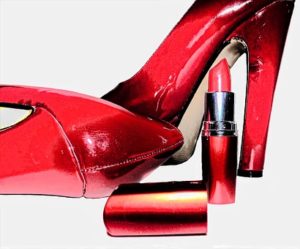 And that leads us to another issue: Books by women cozy authors are often relegated to the pink ghetto. They are given a cute title, a cartoon cover featuring high heels, lipstick, or maybe a cat (and never underestimate the importance of cats in cozies) and sent out into the publishing world with little or no support – and I’m not talking about lingerie. Some of the cozy mysteries published by major houses don’t even rate their own press release. They get a “group release” with three or four other similar cozy authors.
And that leads us to another issue: Books by women cozy authors are often relegated to the pink ghetto. They are given a cute title, a cartoon cover featuring high heels, lipstick, or maybe a cat (and never underestimate the importance of cats in cozies) and sent out into the publishing world with little or no support – and I’m not talking about lingerie. Some of the cozy mysteries published by major houses don’t even rate their own press release. They get a “group release” with three or four other similar cozy authors.
This problem exists for many books written by women. The Boston Globe wrote about a Radcliffe alumni panel on women’s fiction. The article said: “Women of letters have been marginalized since the dawn of Western literature. It is nonetheless surprising that this predicament remains so entrenched. In a yearly study VIDA, an organization for women in the literary arts, reliably finds that major publications still carry more male bylines and cover more books authored by men.
“Although their impact is unquantifiable, book covers certainly have something to do with this disparity. Marketing affects the way readers of both genders perceive the artistic merits of a book. Stereotypically feminine signifiers— a lipstick tube, a woman’s naked back — can inadvertently disqualify a novel from the world of serious literature.”
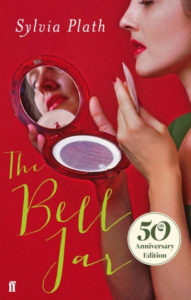 Even literary classics like The Bell Jar aren’t safe, the article said. For the 50th anniversary reissue, the publisher “tarted up Sylvia Plath’s classic novel of existential despondency with an illustration of a woman wearing gobs of eyeliner sneering into a compact. . . . The public outcry was encouraging: In addition to an abundance of op-eds about the cover’s sickening deceptiveness, people designed their own parody reissues of classic novels and shared them on Twitter.”
Even literary classics like The Bell Jar aren’t safe, the article said. For the 50th anniversary reissue, the publisher “tarted up Sylvia Plath’s classic novel of existential despondency with an illustration of a woman wearing gobs of eyeliner sneering into a compact. . . . The public outcry was encouraging: In addition to an abundance of op-eds about the cover’s sickening deceptiveness, people designed their own parody reissues of classic novels and shared them on Twitter.”
The Boston Globe then asks: “So how does a publisher signal to a manly reader that a woman-authored book he has in his hands won’t offend him with talk of motherhood, makeup, and menstruation? How do they assure him this novel is worthy of his time, and possibly a literary prize?
“Enter the ‘man trap,’ a phrase Grove Atlantic vice president and executive editor Elisabeth Schmitz coined for her Radcliffe talk. Schmitz defines the man-trap cover as ‘splashier, brighter, more iconic’ and ‘less gendered’ than its pink ghetto counterparts.
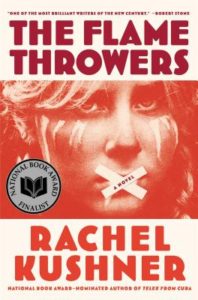 She proffered Rachel Kushner’s National Book Award-nominated The Flamethrowers as a case study. Although the novel concerns a female protagonist’s sexual and artistic awakening, it also dealt with modern art, revolution, and motorcycle racing. Its cover image — a decidedly arty, text-heavy affair with an orange-hued photograph of a blond woman’s face with tape over her mouth — lacked all vestiges of feminine frippery.”
She proffered Rachel Kushner’s National Book Award-nominated The Flamethrowers as a case study. Although the novel concerns a female protagonist’s sexual and artistic awakening, it also dealt with modern art, revolution, and motorcycle racing. Its cover image — a decidedly arty, text-heavy affair with an orange-hued photograph of a blond woman’s face with tape over her mouth — lacked all vestiges of feminine frippery.”
You can read the rest of the article here: https://tinyurl.com/yaouzlws
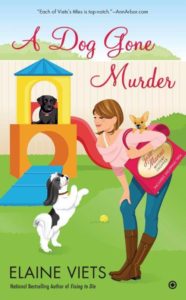 If you want to see the mystery genre difference, look at the cozy cover for my Josie Marcus, Mystery Shopper mystery, A Dog Gone Murder versus the cover for my new Angela Richman, Death Investigator mystery, Ice Blonde. You can’t see it, but Josie’s red bag says the novel “includes shopping tips.” That was the publisher’s idea. I hated those suckers, and killed them in the re-release.
If you want to see the mystery genre difference, look at the cozy cover for my Josie Marcus, Mystery Shopper mystery, A Dog Gone Murder versus the cover for my new Angela Richman, Death Investigator mystery, Ice Blonde. You can’t see it, but Josie’s red bag says the novel “includes shopping tips.” That was the publisher’s idea. I hated those suckers, and killed them in the re-release.
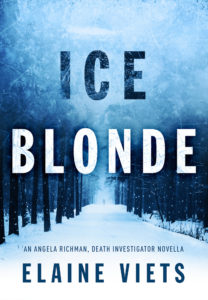
Obviously, the so-called “cutesies” are not your cup of tea, Eric. Some cozies are pure fluff. I don’t read them. But cozies are good ways to explore other occupations and hobbies – hence the knitting and tea shop mysteries – as well as relationships. Women seem to demand this dimension more in their reading than men.
We all have poorly written sub-genres that we don’t enjoy. I won’t discuss the boring thrillers with cardboard protagonists, or clichéd police procedurals with the drunken ex-cop who accidentally shot someone in the line of duty – though Lawrence Block’s Matthew Scudder series takes that tired cliché and turns it into art.
You don’t like what you call “cutesies” and you believe that cozy genre is infested with them. Because of the pink ghetto, you’re missing some fine cozy reading. Here are some cozies with real meat:
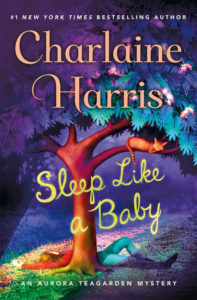 Read Charlaine Harris’s Aurora Teagarden series. Aurora is a small-town librarian, and Charlaine can build real menace into everyday life. Try her latest, Sleep Like a Baby. Or, if you prefer your cozies historical, read Victoria Thompson’s Gaslight series about a Victorian midwife. You’ll learn about social justice, poverty and religious prejudice. Cozies can also address justice and racial equality – for that, I recommend Margaret Maron’s Judge Deborah Knott series.
Read Charlaine Harris’s Aurora Teagarden series. Aurora is a small-town librarian, and Charlaine can build real menace into everyday life. Try her latest, Sleep Like a Baby. Or, if you prefer your cozies historical, read Victoria Thompson’s Gaslight series about a Victorian midwife. You’ll learn about social justice, poverty and religious prejudice. Cozies can also address justice and racial equality – for that, I recommend Margaret Maron’s Judge Deborah Knott series.
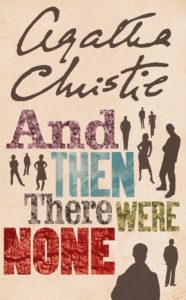 And if you want to see what’s possible in the cozy format, re-read Agatha Christie. I’m currently reading And Then There Were None, which was published under the now offensive title using the N-word. And Then There Were None has a masterful use of multiple characters and a can’t-put-down story. No wonder Christie outsells every author except Shakespeare.
And if you want to see what’s possible in the cozy format, re-read Agatha Christie. I’m currently reading And Then There Were None, which was published under the now offensive title using the N-word. And Then There Were None has a masterful use of multiple characters and a can’t-put-down story. No wonder Christie outsells every author except Shakespeare.
NEXT MONTH: How to market your cozy.

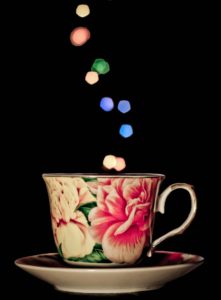

You make excellent points, especially when defining the cozy. I consider my mystery series police procedurals, since the protagonist is a cop, but because he’s developing a relationship with a woman, and I honestly prefer books that go beyond the ‘solve the crime and there is no other life for the cop’ boundaries, I write about his life and dealing with the people he protects in his town. Reviewers often use the word “cozy” when describing the book – “Police procedural with a cozy feel.” Publishers were too confused about how to market it, so I did it myself, and the series is doing well.
The most recent release is a novella set on a cruise ship. This one turned out to be a “cozy” because the protagonist shifted to the cop’s girlfriend. I enjoyed seeing her side of things, and besides, what jurisdiction would my small-town cop have on a cruise ship? So that story technically became a cozy, and I did try to adhere to the expectations.
Frankly, I don’t like anyone dissing any genre. That’s why we have so many books to choose from.
I think we’re in another golden age of mysteries, Terry, and the wide variety is proof.
Another excellent non-“cutesy” cozy author is Nora Barker. Her books feature a female university professor who solves crimes. A very good series.
Thanks, Harvey. I’ll look her up.
There is so much truth in this Elaine. Marketing is useful and hateful at the same time. They certainly adhere to gender stereotypes as well. yet, how many women buy into those stereotypes? I really wonder how much the cutesie covers make a difference? I have to admit I kind of like them at times. That said, if it has a cute cover I tend to expect a level of cuteness but in this day and age that cuteness certainly can go too far with terrible plots and underdeveloped characters. Then all those books give a negative impression towards the genre. I don’t think it is the genre that is the problem, but the proliferation of weak books in the market. unfortunately that makes it easier to miss the great books.
Sometimes I’m in the mood for cute, too, Terri, but t too many badly written cute books leave a bad taste — like any over-indulgence. I wonder what publishing would look like if high heels, lipstick and kitty cats were banned from covers for a year?
Oh, Elaine. This has annoyed me for years and I confess that I am guilty of passing over cutesie covers unless they are by an author I know that I enjoy such as you. I find it very interesting that this is how the trend has gone. If you go back and look at the covers on the mass market reprints of Mary Roberts Rinehart’s books in the 1980s they are rather gruesome, which my husband at the time noticed, I did not. It’s sad that I am now judging books by their covers. I will try to do better.
It’s hard not to judge a book by its cover, Mare. Here’s to more blood and gore on cozy covers.
Oh, you are so right! About a year ago I blogged on the difference between ‘cozy’ and ‘traditional’ mystery. I always thought I wrote cozies – no overt violence, very mild swearing (‘damn’ was about as bad as it got) and no cutsey jobs or hyper-intelligent cats. A very well known Industry Professional (an agent) told me bluntly that to be considered a cozy these days the book has to have a fluffy heroine in an interesting job, a bevy of quirky (his word) secondary characters and at least one heart-throb hero, usually a policeman who tries to keep the heroine from investigating. Oh, and a cat. Usually one who helped with the case. A dog would work in a pinch, but cats were preferred. I was horrified, and decided then and there to wean myself away from traditional publishing. I haven’t regretted it.
So sorry you had to go through that, Janis. Nothing wrong with any of those things in a mystery — unless you’re forced to write them. Sounds like you needed another agent to really represent YOUR writing.
Dear Elaine,
Thank you, thank you, thank you! I have been scrambling for months to find currently published authors who give me the depth, detail, wit and complexity of Dorothy Sayers or Ngaio Marsh. Best find so far (just last week, in fact): Judith Flanders’ A Murder of Magpies. I’ll be reading all the titles you recommend as I continue my search.
For the record, I share Eric’s feelings about cutsies, which he describes so well. They make my teeth itch. But then, I don’t condemn myself for an occasional M&M binge, so why criticize those who prefer to zone out with a craft/food/shopping mystery?
Two other meaty series are Leigh Perry’s “Skeleton” series, set at a college, and Marcia Talley’s Hannah Ives series. Marcia’s “Mile High Murder,” about marijuana laws, got starred reviews — and deserves them.
I’ve read both authors, and loved both!
Those are my favorites too, but I think of them as English Traditional, not American Cozies. The mystery should be the priority with the profession/business secondary and romance at a minimum. JMHO, and how I wrote mine.
Thanks, Elaine. Good info.
I guess I had come to think that if it wasn’t police procedural, thriller or noir/hard-boiled, it was a cozy by default, and that “mystery” or “crime novel”” was the generic name for these subsets. I’m glad to see the comments from others about the unclear definitions.
I’m looking forward to your next installment, on marketing cozies. Can one market a book as a generic “mystery” without taking advantage of the greater exposure that comes from identifying the book with one of the more specific mystery genres?
How is _Ice Blonde_ marketed? Just in the generic “mystery” category? Or as some sub-genre?
Janis, can you post the link to your post on cozies?
Glad this is helpful, Eric. “Ice Blonde” is marketed as a forensic mystery.
Thanks for the info, very useful to consider when planning a mystery series.
Glad it was helpful.
Very informative article. I shared everywhere.
Much appreciated, Catalina.
A tart, fascinating piece. Thanks for all the great reading ideas. Nothing wrong with a few shopping tips, either.
The problem with the shopping tips is they date quickly, Doug. And stores go out of business. Plus they’re so knee-jerk girlie.
I’ve just finished Debbie Burke’s new novel and really enjoyed it. It is definitely a change from the Scandinavian Noir I love. It was a great read and I will continue to read TKZ contributors’ novels no matter the sub genre. Thank goodness there is enough room on the mystery bookshelves for all sorts of good novels.
I hadn’t noticed how tacky the covers for cozies had become. I went to Amazon to check them out and yuck. I didn’t even get a hint of what most of the books were about and most looked like they were illustrated by the same person. I think the The Bell Jar cover in this blog is the worst, especially for a great novel.
Now I really have to try Debbie Burke. “The Bell Jar” cover should win some kind of award for most misleading cover — Sylvia Plath put her head in an oven for heaven’s sake! She was a woman in pain, not someone admiring herself in a mirror.
Wow, Brian, you made my day! Thank you so much. Glad you enjoyed it.
Elaine, I saw one of your books, Checked Out, from the dead-end job mystery series, and I checked itout from the library. The cover has a cat resting on the bottom of a small bookshelf. References to sex were one-liners. (There were some references to drugs.) The book reminds me of the Nancy Drew books I read as a kid. I would have no problem recommending this book to a preteen (would definitely make it clear that I didn’t approve of the drug use by the teens in the book, though). A preteen probably wouldn’t pick up on your commentary about South Florida (funny, btw — I cracked up at the Lilly P. dress reference and that kind of stuff), but there’s no blood and gore (murder happens off the page) that would give anyone nightmares. The language is clear and simple. The book is perfect for ladies (maybe seniors) who want a light beach read and whose tickers can’t take too much of the heart-pounding thriller stuff. These folks make up a good part of the population, btw. The book would make a perfect Mother’s Day gift (maybe with a box of chocolates) for anyone who has a mom or grandma who likes mysteries but doesn’t care for a lot of sex or violence. For folks who like to worry a little more about the protagonist and want a little more of the love story element, I’d recommend something like The Witness, a romantic suspense by Nora Roberts. The wonderful thing about books is that there’s something for everybody. I like to give books as gifts to friends and family, because I think books are such a personal gift; it requires a lot of thought to come up with something perfect for a particular person. For ladies who like thrillers and courtroom drama, etc., there are books like After Anna by Lisa Scottoline. For those who like thrillers with good character development, there’s Friendly Fire by John Gilstrap. For those who enjoy philosophy and prodigy protagonists, there’s Romeo’s Rules by James Scott Bell. And so on. There’s something for every taste, and that’s good. Successful writers know who the tastes of their readers and give those folks what they want.
“know who the tastes of their readers” in last line should read “know the tastes of their readers”
Anyway, forgive my typos… had to type fast.
LOL.
“There’s something for every taste, and that’s good.” Absolutely, Joanne, and that’s the beauty of the mystery genre. It can accommodate a wide range of tastes. I wouldn’t give my Angela Richman series to any sweet grandma. In fact, more than one grandma complained about the bad language. But it fit the character.
The “dead-end job mysteries” were the ones I recommended for the readers who enjoy, let’s say, the tamer side of mysteries. I will definitely look for your Angela Richman series, Elaine. Haven’t seen that series at my local library, but I can find it on Amazon. For myself, I read across genres.
Start with “Brain Storm,” Joanne. “Fire and Ashes” is next and “Ice Blonde” comes out in June.
Will do.
Genre terms and covers are first, and foremost, a marketing tool. At a glance, most readers should be able to see that a book is a mystery of some specific type, romance, science fiction, etc. by its cover, title, and book blurb. The so-called cutsie covers are just the current trend for cozies of a certain type.
The addition of things like crafts and baking in some cozies was yet another marketing ploy to bring in readers who might not ordinarily read a mystery, and it worked so well that most publishers won’t even look at a cozy without that aspect.
There are all kinds of mystery types. Just do a search of “types of mysteries,” and you’ll find some really nice lists. Mystery types are yet another way for the reader to find the type of book they like to read, and God help you if your book is marketed as one type of mystery yet doesn’t follow the formulas the reader expects.
As to the question about “cutsies,” I’ve never heard the term used for mysteries, and genre is one of my academic things. It sounds like a pejorative by someone who thinks only what he reads is right, and in this case, it would be a mystery written by a man with male protagonists and lots of manly man behavior (think Clive Cussler or most movies starring Tom Cruise.)
Women mystery writers have always had a problem with the attitude toward their books. I suggest anyone interested in the subject should read this history of the creation of Sisters in Crime when things were even worse than they are now.
http://www.sistersincrime.org/page/Mission
I know women writers who *ahem* use male pen names or two initials and a last name, because they want their books to appeal to all genders.
“Cutesies was a pejorative term, Marilynn. Sisters in Crime has been a big help to women writers. I’m glad I’m a member.
Hmm. As a man who writes kind of manly-man books that are read mostly by women–as all books are read mostly by women–I wonder if the male/female writer discrepancy is truly gender-oriented. Personally, I find a discrepancy in storytelling sensibilities that is tied first and foremost to genre. I don’t like cats, and I’m not an arts-and-craftsy guy, so those corners of the mystery world don’t attract me. Perhaps someone should start a gunsmithing series with corresponding covers.
I remember reading the Hunger Games series–not cozy by any means, but written by a woman–and loving the first novel. I tolerated the second novel, and I abandoned the third because of the whininess of Katniss Everdeen. Here we have the whole world order in balance, and she’s worrying about whether or not the boy likes her. I wanted to throttle her, and I lost respect in her. I get that it’s officially YA fiction, and that angst is king among adolescents, but I found myself not caring. I would not have cared more if the series had been written by a man.
Like Mark Twain, I prefer a good story well told. Since my mood on one day could be different than on another day, I expect whatever novel I read to fulfill the promise of the premise and the genre. Like you, John, I can’t stand whiny protagonists. I prefer books where I get an immediate sense of a proactive protagonist and a competent writer.
“It sounds like a pejorative by someone who thinks only what he reads is right, and in this case, it would be a mystery written by a man with male protagonists and lots of manly man behavior”
Not so. I came up with the term “cutsie” when I saw one-too-many books with a cartoon cover and a silly pun in the title and tried to read a few. I read more mysteries by women than by men (Christie, Sayers, Allingham, Grafton, Giorello, Leone,…). My complaint is not that there are cutsies or that cutsies are popular but that they seem to have crowded out other offerings in that genre. I was thinking my WIP might be a cozy and concerned with differentiating it from cuties.
My publisher, Cozy Cat Press, only publishes cozies and only one or two series might be considered “cutzies.” Some have male protagonists and many are set in large cities or foreign countries. Some books have senior citizens as the protagonists. I don’t think any books have recipes. My new book with CCP is combination murder mystery/spy caper, so I don’t know what genre to call it!
Congratulations on your new book, Sally. Sounds sounds you’ve already named it — a cozy spy caper. Good luck!
A very fine piece. I don’t write what some people consider an authentic cozy, but my protagonist is a reluctant PI and all the murders, sex, etc. happen off-scene. Also, There is a certain amount of humor in my books, plus designer clothing, and shoes. However, chick-lit they ain’t. I am often categorized with cozies and as I love them, that’s terrific. So often it’s just knowing you’re not following in someone else’s sub-genre. I am a maniac about my covers and feel that helps give the reader a head’s up on my work. I will say that Tugger, the cat, is a part of every story and on every cover. I wouldn’t have it any other way!
Good points, Heather. You sound like a writer in control of your work.
Thanks for spearheading this question, Elaine (and thanks for sharing it on the SinC listserv). There are so many various sub-genres to mystery that there really is something for everyone. I’d only add that different publishers have different brands in terms of packaging/covers and series hooks. Cozy tends to be a catch-all for the lighter side of crime novels, but I’d acknowledge that there’s a very wide range of books that fit under the umbrella, from humorous to literary.
It’s a big umbrella, Diane, with room for us all.
I absolutely fell in love with M.C. Beaton’s Hamish McBeth series. I’ve been told it’s a cozy series, but there are some rather graphic descriptions of corpses from time to time, and the hero is, technically, a law enforcement professional.
I like both Beaton’s series, Carl — Hamish McBeth and Agatha Raisin. They’re considered cozies. Agatha is a very realistic character, a retired ad exec who moves to a small English village.
This is a terrific essay, Elaine, a great job of untangling a lot of pieces of this puzzle. it’s really a marketing issue fundamentally: how to present (classify, cover, etc) a book so it reaches the right readers? I’m sure we all miss books we would enjoy just because the covers scream some message that is not accurate for the …oh, what’s that thing? Oh, yes, the contents. 😉 And fume if it’s our own book badly represented.
It’s true, Triss. I’ve been at signings where people looked at my cartoonish cozy covers and asked, “Are these for children?”
Cartoon cozy covers also put me off. I much prefer the more abstract new covers on your series, Elaine (anyone who hasn’t seen them, you can see them on my blog: http://www.alisonmcmahan.com/news/elaine-viets-dead-end-jobs-series-goes-digital
To answer the person who posed the original question, I think there is a trend overall towards bad covers. Indie and small presses sometimes don’t want to pay a good graphic artist what they are due. The result is repetition of the same stock images, clumped together in unimaginative ways, over and over again, with titles in jarring colors thrown on top without any shadowing or depth added to the letters.
And whoever came up with that cover for the Bell Jar should get jail time…
Definitely in jail for that Bell Jar clinker of a cover, Alison. And I have heard authors mourn that “their” cover image appeared on another book — the girl in the red coat, the back of the woman in the white dress , etc.
I experienced the opposite side of the problem when I tried to sell the first of my golden retriever mysteries, which have two male protagonists (guy and dog.) Agents and editors said that readers wouldn’t buy cozy/traditional mysteries with male sleuths, so I self-pubbed. And all my readers don’t seem to care, as long as there’s a good mystery and some fun dog antics. I do try to convey the cozy side through punning names (In Dog We Trust and so on.)
Glad you didn’t listen to your agent, Neil. Your books seem to be doing well.
I call my Hazel Rose Book Group series “cozy with a touch of noir.” When my first book was accepted I was amazed when my editor objected to my cuss words. “I’m reading this cute little cozy and all of a suddenly someone uses the f-word” were her words. I had no idea it was a cozy but could accept the designation—but I did object to “cute” and “little.” I still have issues. Sigh.
I feel your pain, Maggie. Keep fighting to write your books, not someone else’s.
That’s my plan. I hope to see you at Malice.
Yes, the need to place my series in a specific genre for marketing purposes drives me crazy, too. My Sally Solari mysteries are marketed by my publisher as cozies, but fall in that nebulous (for marketing purposes) land between cozies and traditionals. They take place in a small town and concern an amateur sleuth and restaurants, but because they deal with social issues, contain the odd swear word, and are not particularly “cutsy,” I’ve come up with the term “snarky cozies” for them. Maybe the phrase will catch on and become a new subgenre–I’m hoping!
Thanks for this discussion. I’ve been concerned about several issues in categorizing my Safe Harbor Medical mysteries, told from the viewpoint of a doctor. While they take place in a medical setting, they aren’t thrillers about someone devising a weapons-grade virus or sneakily murdering patients. They’re true traditional mysteries with a puzzle (or several) and clues, involving my protagonist’s patients and/or colleagues.
While these books might be considered cozies, too many cozies that I’ve read play fast and loose with police procedures. I research heavily (I’m a former Associated Press reporter) and a friend who’s a retired sheriff’s investigator reads all my stuff for accuracy. As do several nurses and a prosecutor, who generously serve as beta readers for me.
I incorporate humor, but it springs from personalities, not klutziness or cuteness. Yet I’m concerned that the traditional mystery category sounds too bland, and is easily overlooked.
Due to dissatisfaction with traditional publishing, I’m self-publishing this series (after selling about a hundred mysteries, romances and other novels). That presents yet another challenge.
Thanks for letting me ruminate in public. I appreciate your site!
Elaine,
Thanks so for this smart, trenchant analysis. Not to mention calm and rational. I’m trying to follow your lead in my response.
As a proud writer of cozies–that yes, have their light moments, but also tight plots, realistic dialogue and strong writing–I have to say that relegating my work to a term like “cutesie,” really gets my back up. (Sort of like an angry. . .cat.) Eric, you explain that you tried to read a few cozies you considered “cute,” and found them lacking, and your worry is “that cutesies are popular but that they seem to have crowded out other offerings in that genre.” Such as your own, perhaps? The message I am also taking, intended or not, is that your book has traditionally cozy elements, but you certainly don’t want it lumped in with work you deem inferior.
To address the first point, the mystery genre is wide and deep, as Elaine has noted, and there is always room for a first-rate story. As to your second point, I would be very careful about disparaging an entire group of authors. You might need one of them to blurb your book someday.
Rosie Genova
Author of the Italian Kitchen Mysteries, NAL/Penguin
I’m a big Cozy fan. I’ve notice I skip any book with a woman wearing high heels or tight outfits on the cover. I also don’t like cozies with a story dealing with weddings. Too frou-frou & stressful. Elope and get it over with. I do love cozies with cats in them. A nice touch.
I’ve been in a Cozy mystery reading group for five years. We have the best time laughing. I think maybe people that like cozies need an escape from the stresses in their lives and the world. I used to read the rough mysteries when I was in my 20s, 30s, & 40s. I was a big Patricia Cornwell fan for example. Then suddenly in my 50s I just wanted to escape from the realistic world for a while. I no longer can tolerate sadistic violence, sexual violence, etc. Give me a “cutesy” Cozy and I’ll be happy and laughing. I do want more positive diverse characters (LGBT, race, cultural, religion, etc) in Cozies and am seeing more of that. Diverse characters that are positive and themselves without it being a big deal. I search for those books. Also, nice humor is beautiful. Happy reading, y’all!
Also, Elaine, thank you for covering this question so well!
Thank you, and thanks to Eric, who came up with a good topic.
You brought up a good point, Cheryl. Many people read cozies just for fun — some are bonbon books, and good with a cup of tea. I do find that cozies tackle issues many other sub-genres avoid, especially LGTBQ issues, with believable characters.
Pingback: Writing Links…4/16/18 – Where Genres Collide
Excellent post, Elaine! I enjoy reading and writing cozies because they take me away from the news I see every day and make me smile. Often I laugh, too, and I love to laugh. I like creating books that are fun for me to write and the reader to read.
I’ve read your cozies, June. They’re fun and well-written.